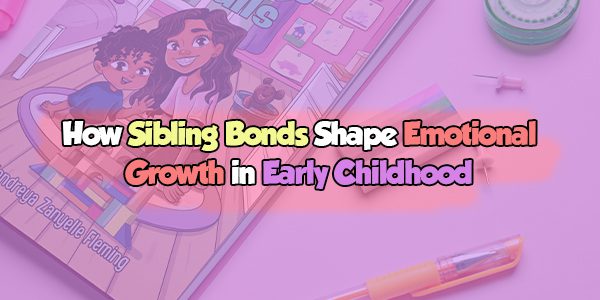There’s something beautifully messy about watching siblings grow up together. One minute, they’re giggling over a shared game. Next, they’re fighting over who gets the red crayon. And somewhere in between, something extraordinary is happening.
In those tiny moments of play, conflict, and compromise, siblings are helping shape each other’s emotional world. It’s not always easy, and it’s definitely not always peaceful. But it’s real. And it’s powerful.
As parents, caregivers, or even educators, understanding how sibling bonds impact emotional growth in the early years gives us the opportunity to guide those relationships gently and to appreciate them more deeply.
The First Playground for Emotions
For many children, a sibling is their first peer. They are the first person to share space, toys, and attention with. They are also the first person who pushes their buttons and teaches them how to manage frustration.
This relationship becomes a sort of emotional playground. It’s where children begin to explore feelings like jealousy, pride, empathy, and forgiveness.
When your toddler shares a toy with their baby sister, they’re not just learning how to take turns. They’re learning how it feels to be generous. When your preschooler yells because their brother knocked down their blocks, they’re beginning to navigate disappointment and anger.
These daily interactions might seem small, but they are building emotional muscles that children will carry into friendships, school settings, and eventually, adulthood.
Learning Empathy in Real Time
Siblings offer constant opportunities to practice empathy. Children get to witness one another’s joys and hurts up close. They begin to notice the subtle signs of emotion in each other. A pout. A tear. A giggle that turns into a belly laugh.
Sometimes, this recognition sparks compassion. A big sister might bring a blanket when her younger brother is upset. A toddler might offer a half-eaten snack to their crying sibling.
And yes, sometimes they completely miss the mark. They might laugh at the wrong time or take pleasure in a sibling’s mistake. But even in those awkward moments, they’re learning. They’re figuring out what feels good and what doesn’t in a relationship.
Empathy is not something you teach once. It is something that grows through experience. Sibling relationships provide those experiences every single day.
The Role of Conflict in Growth
Here’s the truth, many of us already know sibling conflict is normal. It’s actually more than normal. It’s healthy when guided well.
When children argue, disagree, or even fight, they’re practicing essential emotional skills. They are learning how to advocate for themselves, how to listen (eventually), and how to resolve differences.
Of course, it takes time. A lot of time. As adults, it’s easy to feel frustrated by the constant bickering or competition. But conflict gives us as caregivers the chance to teach important lessons like:
- “You can be mad, but you cannot hit.”
- “Let’s take turns talking so everyone feels heard.”
- “How can we solve this together?”
We are not just breaking up fights. We are helping our kids build tools for healthy emotional regulation.
The Gift of Belonging and Support
Beyond the emotional growing pains, sibling bonds offer something incredibly grounding, a sense of belonging.
When a child knows that their sibling is there at the breakfast table, in the backseat during road trips, or on the other side of the bunk bed at night, it creates a quiet comfort. It’s a constant in a world that often changes.
For children who are shy or have a hard time with social situations, a sibling can be their first best friend. A safe partner to try new games with, to tell secrets to, or just to sit beside in silence.
And during difficult times, whether it’s the first day of preschool or a tough doctor’s visit, siblings often show up in ways we don’t expect. A hand was held tightly. A whispered joke. A shared glance that says, “I’ve got you.”
Each Bond is Unique
It’s important to remember that not all sibling relationships look the same. Some children are incredibly close, while others need more space. Some bonds blossom early, while others grow stronger over time.
There’s no single formula. But all sibling dynamics, even the tricky ones, can contribute to emotional development.
The key is creating an environment where love, respect, and boundaries are modeled. Where kids feel safe to express themselves and learn from their mistakes. Where forgiveness is offered and empathy is encouraged.
How We Can Support Their Bond
As adults, we don’t need to control every interaction between siblings. But we can support their emotional growth by:
1. Modeling healthy relationships ourselves. Kids watch how we handle conflict, affection, and communication.
2. Encouraging kindness and teamwork. Give them tasks to do together, like setting the table or cleaning up toys.
3. Celebrating their unique strengths. Avoid constant comparison. Each child brings something special to the bond.
4. Making space for one-on-one time. Sometimes, kids just need individual attention to feel secure in their place within the family.
5. Letting them solve problems when they can. With age-appropriate guidance, allow kids to work through disagreements.
A Final Thought
The bond between siblings is one of the most complex, enduring, and influential relationships in a child’s life. It’s not perfect. It’s not always peaceful. But it is a space rich with opportunity.
Through laughter, rivalry, shared stories, and squabbles, siblings help one another become more emotionally aware, resilient, and connected.
So next time you hear them arguing over a toy or laughing uncontrollably at bedtime, take a deep breath and smile. Their bond – messy as it may be – is helping shape the hearts of who they are becoming.

